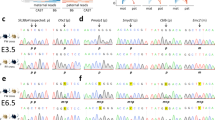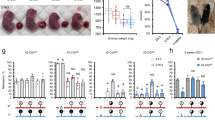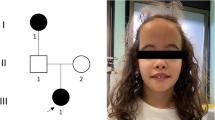Abstract
Genetic and embryological studies in the mouse demonstrated functional differences between parental chromosomes during development1–3. This is due to imprinted genes whose expression is dependent on their parental origin4,5. In a recent systematic screen for imprinted genes, we detected Peg3 (paternally expressed gene 3)6. Peg3 is not expressed in parthenogenones. In interspecific hybrids, only the paternal copy of the gene is expressed in the embryos, individual tissues examined in d9.5–13.5 embryos, neonates and adults. Peg3 mRNA is a 9 kb transcript encoding an unusual zinc finger protein with eleven widely spaced C2H2 type motifs and two groups of amino acid repeats. Peg3 is expressed in early somites, branchial arches and other mesodermal tissues, as well as in the hypothalamus. Peg3 maps to the proximal region of chromosome 7. Consistent with our findings, maternal duplication of the proximal chromosome 7 causes neonatal lethality7–9. This region is syntenic with human chromosome 19q13.1–13.3 (refs 10,11), where the genes for myotonic dystrophy and a putative tumour suppressor gene are located12,13.
This is a preview of subscription content, access via your institution
Access options
Subscribe to this journal
Receive 12 print issues and online access
$209.00 per year
only $17.42 per issue
Buy this article
- Purchase on Springer Link
- Instant access to full article PDF
Prices may be subject to local taxes which are calculated during checkout
Similar content being viewed by others
References
Cattanach, B.M. & Jones, J. Genetic imprinting in the mouse: Implications for gene regulation. J. Inter. Metab. Dis. 17, 403–420 (1994).
McGrath, J. & Solter, D. Completion of mouse embryogenesis requires both the materal and paternal genomes. Cell. 37, 179–183 (1984).
Surani, M.A., Barton, B.C. & Morris, M.L. Nuclear transplantation in the mouse: heritable differences between parental genomes after activation of the embryonic genome. Cell 45, 127–136 (1986).
Reik, W. Genomic imprinting and genetic disorders in man. Trends Genet. 5, 331–336 (1989).
Efstratiadis, A. Parental imprinting of autosomal mammalian genes. Curr. Opin. Genet. Dev. 4, 265–280 (1994).
Kaneko-lshino, T. et al. Peg1/Mest imprinted gene on mouse chromosome 6 identified by cDNA subtraction hybridization. Nature Genet. 11, 52–59 (1995).
Searle, A.G. & Beechey, C.V. Genome imprinting phenomena on mouse chromosome 7. Genet. Res. 56, 237–244 (1990).
Cattanach, B.M. et al. A candidate mouse model for Prader-Willi syndrome which shows an absence of Snrpn expression. Nature Genet. 2, 270–274 (1992).
Barr, J.A., Jones, J., Glenister, P.H & Cattanach, B.M. (1995) Ubiquitous expression and imprinting of Snrpn in the mouse. Mammalian Genome 6, 405–407 (1995).
Brown, S.D.M., Chartier, F., Johnson, K. & Cavanna, J.S. Mapping the Hrc gene to proximal mouse chromosome 7: Delineation of a conserved linkage group with human 19q. Genomics. 18, 459–461 (1993).
Jansen, G. et al. No imprintng involved in the expression of DM-kinase mRNA in mouse and human tissues. Hum. Mol. Genet. 8, 1221–1227 (1993).
Rubio, M-P et al. The putative glioma tumor suppressor gene on chromosome 19q maps between APOC2 and HRC. Cancer Res. 54, 4760–4763 (1994).
Yong, W.H. et al. Chromosome 19q deletions in human gliomas overlap telomeric to D19S219 and may target a 425 kb region centromeric to D19S112. J Neuropath. & Exp. Neurol. 54, 622–626 (1995).
Jacobs, G.H. Determination of the base recognition positions of zinc fingers from sequence analysis. EMBO J. 11, 4507–4517 (1992).
Pavletich, N.P. & Pabo, C.O. Zinc finger-DNA recognition: crystal structure of a Zif268-DNA complex at 2.1 A. Science 252, 809–817 (1991).
Pavletich, N.P. & Pabo, C.O. Crystal structure of a five-finger GLI-DNA complex: new perspectives on zinc fingers. Science. 261, 1701–1707 (1993).
Fairall, L., Schwabe, J.W., Chapman, L., Finch, J.T. & Rhodes, D. The crystal structure of a two zinc-finger peptide reveals an extension to the rules for zinc-finger/DNA recognition. Nature. 366, 483–487 (1993).
Tada, M. et at. Localization of mouse imprinted gene U2af1-rs1 to A3.2–4 band of chromosome 11 by FISH. Mammalian Genome. 5, 655–657 (1994).
Dietrich, W.F. et at. A genetic map of the mouse with 4,006 simple sequence length polymorphism. Nature Genet. 7, 220–245 (1994).
Leff, S.E. et at. Maternal imprinting of the mouse Snrpn gene and conserved linkage homology with the human Prader-Willi syndrome region. Nature Genet. 2, 259–264 (1992).
Mandel, J.-L. Questions of expansion. Nature Genet. 4, 8–9 (1993).
Barton, S.C., Ferguson-Smith, A.C., Fundele, R. & Surani, M.A. Influence of paternally imprinted genes on development. Development. 113, 679–688 (1991).
Chomczynski, P.A. Reagent for the single-step simultaneous isolation of RNA, DNA and proteins from cell and tissue samples. BioTechniques. 15, 532–536 (1993).
Lawrence, J.B., Singer, R.H. & Marselle, L.M. Highly localised tracks of specific transcripts within interphase nuclei visualized by in situ hybridization. Cell. 57, 493–502 (1989).
Pinkel, D., Strume, T. & Gray, J.W. Cytogenetic analysis using quantitative, highly sensitive, fluorescence hybridization. Proc. Natl. Acad. Sci USA 83, 3583–3589 (1994).
Hayashizaki, Y. et al. A genetic linkage map of the mouse using Restriction Landmark Genomic Scanning (RLGS). Genetics. 138, 1207–1238 (1994).
Bairoch, A. & Bucher, P. PROSITE: recent developments. Nucl. Acids Res. 22, 3583–3589 (1994).
Higgins, S.G. & Sharp, P.M. A package for performing multiple sequence alingnments on a microcomputer. Gene 73, 237–244 (1988).
Wilkinson, D.G. & Green, J. In situ hybridization and the three dimensional reconstruction of serial sections. In Postimplantation Mammalian Embryo, (eds Copp, A.J. & Cockroft, D.J.) 155–171 (Oxford IRL Press, 1990).
Gubbay, J. et al. Inverted repeat structure of the Sry locus in mice. Proc. Natl. Acad. Sci. USA 89, 7953–7957 (1992).
Author information
Authors and Affiliations
Rights and permissions
About this article
Cite this article
Kuroiwa, Y., Kaneko-Ishino, T., Kagitani, F. et al. Peg3 imprinted gene on proximal chromosome 7 encodes for a zinc finger protein. Nat Genet 12, 186–190 (1996). https://doi.org/10.1038/ng0296-186
Received:
Accepted:
Issue Date:
DOI: https://doi.org/10.1038/ng0296-186
This article is cited by
-
Hypoxia promotes a perinatal-like progenitor state in the adult murine epicardium
Scientific Reports (2022)
-
The imprinted gene Pw1/Peg3 regulates skeletal muscle growth, satellite cell metabolic state, and self-renewal
Scientific Reports (2018)
-
Reduced expression of Paternally Expressed Gene-3 enhances somatic cell reprogramming through mitochondrial activity perturbation
Scientific Reports (2017)
-
Parental and sexual conflicts over the Peg3 imprinted domain
Scientific Reports (2016)
-
Alternative promoters of Peg3 with maternal specificity
Scientific Reports (2016)



